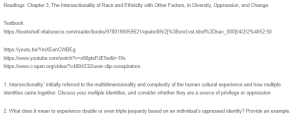Discussion – Intersectionality and Double or Triple Jeopardy
Intersectionality is used to explain the interrelation of various dimensions that make an identity-for example, race, gender, class, and sexuality (Kimberlé Crenshaw, 1989). It is important to bring out how different dimensions of discrimination meet and add up to create challenges for people from marginal groups. As I reflect on my own multiple identities, I have learned that each can contribute to privilege and oppression in different contexts. For example, my racial identity places me among those from marginalized groups who are stereotyped and set up for systemic biases. However, my educational background and socioeconomic status often give me privileges that counterbalance a part of the discrimination I faced. This interplay-what happens between privilege and oppression-is the very underpinning of the intersectionality concept, which makes the point that identities can’t be gained in isolation; instead, they have to be put into the context of how they interrelate to one another. (Marsiglia et al., 2020)
Double or Triple Jeopardy
Double or triple jeopardy refers to mutual disadvantage experienced by people from intersecting groups. For instance, a black female with a disability would experience racism, sexism, and ableism in an additive way to form a peculiar and heightened experience of discrimination. MSNBC’s video (2015) further elaborates that black females often find themselves standing at the intersection of racial and gender biases playing out. Because of this, both the anti-racist and feminist movements tend to neglect them too. This triple jeopardy not only heightens the discrimination they face but, at times, ruptures social cohesion altogether.
Intersectionality has thus been a helpful framework in fleshing out how the different axes of identity intersect in the production of individual experiences of privilege and oppression. It requires work to understand various intersections and how they might be honored and named in the pursuit of a society characterized by equity and inclusion.
References
Crenshaw, K. (1989). Demarginalizing the intersection of race and sex: A Black feminist critique of anti-discrimination doctrine, feminist theory, and antiracist politics. The University of ChicagoLegalForum,1989(1),139167.https://chicagounbound.uchicago.edu/uclf/vol1989/iss1/8
Marsiglia, F. F., & Kulis, S. S. (2020). Diversity, oppression, & change: Culturally grounded
Social work (2nd ed.). Oxford University Press.
MSNBC. (2015, July 3). Bree Newsome exclusive | All In. [Video]. YouTube. https://youtu.be/YmXEenCWBEg
ORDER A PLAGIARISM-FREE PAPER HERE
We’ll write everything from scratch
Question
Readings: Chapter 3, The Intersectionality of Race and Ethnicity with Other Factors, in Diversity, Oppression, and Change.
Textbook:

Discussion – Intersectionality and Double or Triple Jeopardy
https://bookshelf.vitalsource.com/reader/books/9780190059521/epubcfi/6/2[%3Bvnd.vst.idref%3Dnav_000]!/4/2/2%4052:50
https://www.c-span.org/video/?c4804332/user-clip-conspirators
1. Intersectionality” initially referred to the multidimensionality and complexity of the human cultural experience and how multiple identities came together. Discuss your multiple identities, and consider whether they are a source of privilege or oppression.
2. What does it mean to experience double or even triple jeopardy based on an individual’s oppressed identity? Provide an example.

